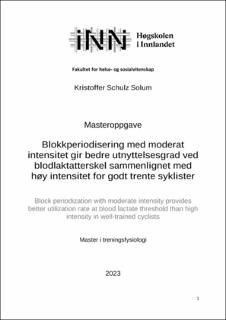Blokkperiodisering med moderat intensitet gir bedre utnyttelsesgrad ved blodlaktatterskel sammenlignet med høy intensitet for godt trente syklister
Master thesis
Permanent lenke
https://hdl.handle.net/11250/3074069Utgivelsesdato
2023Metadata
Vis full innførselSamlinger
Sammendrag
Introduksjon: Blokkperiodisering med høyintensitetstrening (HIT) forbedrer utholdenhetsprestasjon, inkludert maksimalt oksygenopptak (V̇O2maks), maksimal aerob arbeidsbelastning (Wmaks), effekt ved blodlaktatkonsentrasjon ([La-]) 2mmol·L-1 og test til utmattelse sammenlignet med tradisjonell trening. Formålet med denne studien var å sammenligne moderat intensitetstrening (MIT) og HIT, begge gjennomført som en blokkperiode (BP), for å undersøke hvilken av protokollene forbedret variabler viktig for utholdenhetsprestasjon.
Metode: Godt trente mannlige (n = 21) og kvinnelige (n = 1) syklister (V̇O2maks = 69.5 ± 5.9 mL·min-1·kg-1) gjennomførte to forskjellige mikrosyklus (~1 uke) BP- protokoller, MIT og HIT. Intervallene og belastningen på protokollene var som følgende; MIT, 7x10min, 6x12min, 5x14min, hviledag, 7x10min, 5x14 og 6x12 med en opplevd anstrengelse på 14-15 (RPE; Borg skala 6-20) og HIT, 5 økter med 5x8:45min:sek gjennomført med varierende intensitet (30s/15s) med RPE 16-18.
Resultat: MIT hadde forskjell i utnyttingsgrad ved blodlaktatterskel sammenlignet med HIT (hhv. 1.17 ± 3.42%- poeng og -0.86 ± 2.42%- poeng, p = 0.024) og tendens til forskjell i effekt ved blodlaktatterskel (hhv. 13 ± 11.2w og 7 ± 8.1w, p = 0.056). MIT hadde også tendens til forbedring i utnyttingsgrad ved 15 min prestasjonstest sammenlignet med HIT (hhv. 0.28 ± 3.51% og -1.57 ± 3.64%, p = 0.098). Det var ingen forskjell i endring mellom MIT og HIT i V̇O2maks, Wmaks, effekt ved 15 min prestasjonstest og arbeidsøkonomi.
Konklusjon: Godt trente syklister forbedret i utnyttingsgrad ved blodlaktatterskel, tendens til forbedring i effekt ved blodlaktatterskel og tendens til forbedring i utnyttingsgrad ved 15 prestasjonstest ved MIT-blokk sammenlignet med HIT-blokk. Det var ingen forskjell i endring mellom gruppene i V̇O2maks, Wmaks og effekt ved 15 min prestasjonstest. Introduction: High-intensity interval training (HIT) in block periodization has been shown to improve endurance performance, including maximal oxygen uptake (V̇O2max), maximal aerobic power (Wmax), power output at blood lactate concentration of 2mmol·L-1 ([La-]), and time to exhaustion compared to traditional training. The purpose of this study was to compare the effectiveness of moderate-intensity interval training (MIT) and HIT, both implemented in a block periodization (BP), to determine which protocol would result in greater improvements in key endurance performance variables.
Methods: 22 well-trained male (n = 21) and female (n = 1) cyclists (V̇O2max = 69.5 ± 5.9 mL·min-1·kg-1) completed two different microsyclus (~1 week) BP protocols, MIT and HIT. The intervals and workload for the protocols were as follows; MIT, 7x10min, 6x12min, 5x14min, restday, 7x10min, 5x14min and 6x12 with a perceived exhaustion (RPE; Borg 14-15) and HIT, 5 sessions of 5x8:45min:sec performed as (30s/15s) (16-18 RPE).
Results: MIT showed a greater improvement in utilization rate at lactate threshold (1.17 ± 3.42 %-points and -0.86 ± 2.42 %-points, p = 0.024) and a tendency to greater improvement in power output at blood lactate threshold compared to HIT (13 ± 11.2 W and 7 ± 8.1 W, p = 0.056). MIT also had a tendency for a greater improvement in utilization rate during a 15-minute performance test (0.28 ± 3.51 %-points and -1.57 ± 3.64 %-points, p = 0.098). There was no difference between MIT and HIT in V̇O2max, Wmax, 15-minute performance test, and exercise efficiency (GE).
Conclusion: Well-trained cyclists showed improvement in utilization rate at blood lactate threshold, a tendency to improvement in blood lactate threshold power output, and a tendency towards improvement in utilization rate during a 15-minute performance test after a MIT- block compared to a HIT- block. There were no differences in V̇O2max, Wmax, and 15-minute performance test.
